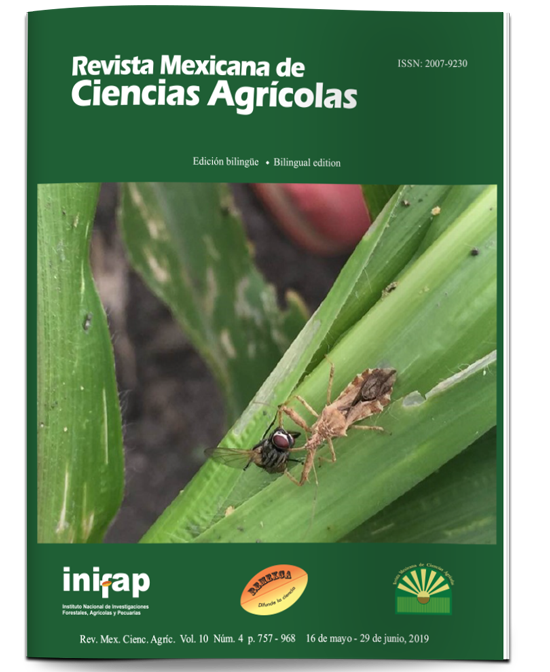First report of Nodulosporium (Xylariaceae) in Theobroma cacao L. in Chiapas, Mexico and pathogenicity tests
DOI:
https://doi.org/10.29312/remexca.v10i4.1657Keywords:
Hypoxylon, Nodulosporium, Chiapas, cocoa, phytopathogenic fungiAbstract
Nodulosporium is a widely distributed fungus found in tropical areas and has been reported as a phytopathogen causing descending death, rot and resinosis, it is also considered as a potential agent of biological control of other fungi and oomycetes. The teleomorphic state is solitary and in clusters, and has been reported as an endophyte, saprophyte or weak phytopathogen. The creole cacao variety Theobroma cacao is of great ecological, economic and cultural relevance in the state of Chiapas; however, it presents high susceptibility to diseases unlike other important varieties, affecting quality and production. In Villa de Comaltitlan Chiapas, cacao fruits with typical characteristics of rot symptoms were observed. The objective was to identify the fungi associated with sick cocoa fruits with symptoms of rot. The fungi Aspergillus sp., Penicillium sp., Rhizopus sp., Trichoderma sp., and Nodulosporium sp. were identified morphologically. The presence of Nodulosporium sp. is reported for the first time, in cacao fruits with rot symptoms of Villa de Comaltitlan, Chiapas, Mexico. The morphological and morphometric characteristics of Nodulosporium sp. and Hypoxylon sp., and its molecular identification. The pathogenicity of Nodulosporium sp. was confirmed in foliage of the crop causing chlorosis and dehydration of the leaf, and it was recovered in the form of pycnidia and mycelium with conidia, corresponding to its teleomorph, identified as Hypoxylon morphologically and molecularly with the oligonucleotides ITS4-ITS5.
Downloads
Downloads
Published
How to Cite
Issue
Section
License
The authors who publish in Revista Mexicana de Ciencias Agrícolas accept the following conditions:
In accordance with copyright laws, Revista Mexicana de Ciencias Agrícolas recognizes and respects the authors’ moral right and ownership of property rights which will be transferred to the journal for dissemination in open access. Invariably, all the authors have to sign a letter of transfer of property rights and of originality of the article to Instituto Nacional de Investigaciones Forestales, Agrícolas y Pecuarias (INIFAP) [National Institute of Forestry, Agricultural and Livestock Research]. The author(s) must pay a fee for the reception of articles before proceeding to editorial review.
All the texts published by Revista Mexicana de Ciencias Agrícolas —with no exception— are distributed under a Creative Commons License Attribution-NonCommercial 4.0 International (CC BY-NC 4.0), which allows third parties to use the publication as long as the work’s authorship and its first publication in this journal are mentioned.
The author(s) can enter into independent and additional contractual agreements for the nonexclusive distribution of the version of the article published in Revista Mexicana de Ciencias Agrícolas (for example include it into an institutional repository or publish it in a book) as long as it is clearly and explicitly indicated that the work was published for the first time in Revista Mexicana de Ciencias Agrícolas.
For all the above, the authors shall send the Letter-transfer of Property Rights for the first publication duly filled in and signed by the author(s). This form must be sent as a PDF file to: revista_atm@yahoo.com.mx; cienciasagricola@inifap.gob.mx; remexca2017@gmail.
This work is licensed under a Creative Commons Attribution-Noncommercial 4.0 International license.



